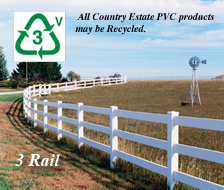
PVC & The Environment
The Energy and the Environmental Benefits of PVC Building Products
PVC building products have numerous energy and environmental benefits. Since the late 1980s, more than 20 life-cycle evaluations have been completed on PVC building products, many of them comparing those products to similar products made of other materials. PVC products were found to perform favorably in terms of energy efficiency, thermal-insulating value and low contribution to greenhouse gases and product durability, which means using fewer resources.
EXAMPLES:
Energy efficiency and reduced greenhouse gas emissions. PVC saves energy and reduces CO2 emissions. PVC takes less energy to produce than many competing products, and 20 percent less than other plastics. PVC also saves fossil fuels. Its principal raw material (nearly 60 percent) is chlorine derived from common salt. PVC building products are highly energy-efficient.
Durability. PVC building products are highly durable, which conserves resources. They will not rot or corrode like many other materials and do not need cleaning with harsh chemicals or frequent painting. PVC’s durability is an important environmental benefit, because the longer a product lasts, the less energy and other resources must be expended to make and install replacement products. PVC also conserves energy in manufacture and more importantly in use.
Recycling. PVC is inherently recyclable. Because vinyl is a thermoplastic, it can be reheated, melted and used again. A recent study determined that more than 99 percent of all vinyl ends up in a finished product. Even the vinyl sawdust that is created by decking installation can be put back into the recycling stream. No paints or stains are left over requiring special treatment for disposal, and no preservative chemicals are needed thereby eliminating potential absorption into the ground water. More than 1 billion pounds are recycled annually (mostly post-industrial), according to a recent study. Many carpet manufacturers using PVC backing have highly successful recycling programs, including C&A Floorcoverings (which has recycled over 100 million pounds of vinyl backed carpet). The Vinyl Institute recently won an award from WasteCap Wisconsin for support in recycling vinyl siding cutoffs at job sites.
Water savings. 2.3 trillion gallons of treated water are lost every year because of leaks from aging, corroded metal pipes. Because PVC pipes do not corrode and have among the lowest pipe breaks, they save precious water resources.
Resource Conservation. As with all resources, the use of wood has consequences for the environment - especially the loss of habitat and soil from over-harvesting and old growth forests that produce the best wood.
DID YOU KNOW …That the vinyl polymer is more than 50% derived from salt, one of the most plentiful natural resources on earth?
Life cycle analysis. PVC’s impacts on the environment are comparable to or lower than most alternatives. A 2004 study of environmental life-cycle analyses (LCAs) of PVC and competing building materials by the European Commission (EC) found that PVC offers environmental benefits equal to or better than those of other materials in many applications.1 The USGBC PVC Task Group reached similar conclusions in its draft report issued December 2004.
What about…
• Dioxin? PVC is an extremely small source of dioxin, so small that levels in the environment would be essentially unchanged even if vinyl were not being manufactured and used every day in important products. The proof: dioxin levels in the environment have been declining for decades, according to data from the U.S. Environmental Protection Agency. During this time, production and use of vinyl have soared.
• Worker Safety? OSHA statistics show that injury and illness rates among PVC workers are significantly less than the manufacturing average. In the 1970s, industry scientists discovered that vinyl chloride, a chemical used to make PVC, could cause angiosarcoma, a rare form of liver cancer, in workers exposed at that time to very high doses. This led to a complete overhaul of the PVC production process, which became essentially a closed loop, recycling wastes back into production and minimizing worker exposure. The U.S. Occupational Safety and Health Administration issued strict regulations in 1975, and there have been no documented cases of angiosarcoma among PVC production workers whose careers in the industry began after the new regulations were promulgated.
The Energy and the Environmental Benefits of PVC Building Products
PVC building products have numerous energy and environmental benefits. Since the late 1980s, more than 20 life-cycle evaluations have been completed on PVC building products, many of them comparing those products to similar products made of other materials. PVC products were found to perform favorably in terms of energy efficiency, thermal-insulating value and low contribution to greenhouse gases and product durability, which means using fewer resources.
EXAMPLES:
Energy efficiency and reduced greenhouse gas emissions. PVC saves energy and reduces CO2 emissions. PVC takes less energy to produce than many competing products, and 20 percent less than other plastics. PVC also saves fossil fuels. Its principal raw material (nearly 60 percent) is chlorine derived from common salt. PVC building products are highly energy-efficient.
Durability. PVC building products are highly durable, which conserves resources. They will not rot or corrode like many other materials and do not need cleaning with harsh chemicals or frequent painting. PVC’s durability is an important environmental benefit, because the longer a product lasts, the less energy and other resources must be expended to make and install replacement products. PVC also conserves energy in manufacture and more importantly in use.
Recycling. PVC is inherently recyclable. Because vinyl is a thermoplastic, it can be reheated, melted and used again. A recent study determined that more than 99 percent of all vinyl ends up in a finished product. Even the vinyl sawdust that is created by decking installation can be put back into the recycling stream. No paints or stains are left over requiring special treatment for disposal, and no preservative chemicals are needed thereby eliminating potential absorption into the ground water. More than 1 billion pounds are recycled annually (mostly post-industrial), according to a recent study. Many carpet manufacturers using PVC backing have highly successful recycling programs, including C&A Floorcoverings (which has recycled over 100 million pounds of vinyl backed carpet). The Vinyl Institute recently won an award from WasteCap Wisconsin for support in recycling vinyl siding cutoffs at job sites.
Water savings. 2.3 trillion gallons of treated water are lost every year because of leaks from aging, corroded metal pipes. Because PVC pipes do not corrode and have among the lowest pipe breaks, they save precious water resources.
Resource Conservation. As with all resources, the use of wood has consequences for the environment - especially the loss of habitat and soil from over-harvesting and old growth forests that produce the best wood.
DID YOU KNOW …That the vinyl polymer is more than 50% derived from salt, one of the most plentiful natural resources on earth?
Life cycle analysis. PVC’s impacts on the environment are comparable to or lower than most alternatives. A 2004 study of environmental life-cycle analyses (LCAs) of PVC and competing building materials by the European Commission (EC) found that PVC offers environmental benefits equal to or better than those of other materials in many applications.1 The USGBC PVC Task Group reached similar conclusions in its draft report issued December 2004.
What about…
• Dioxin? PVC is an extremely small source of dioxin, so small that levels in the environment would be essentially unchanged even if vinyl were not being manufactured and used every day in important products. The proof: dioxin levels in the environment have been declining for decades, according to data from the U.S. Environmental Protection Agency. During this time, production and use of vinyl have soared.
• Worker Safety? OSHA statistics show that injury and illness rates among PVC workers are significantly less than the manufacturing average. In the 1970s, industry scientists discovered that vinyl chloride, a chemical used to make PVC, could cause angiosarcoma, a rare form of liver cancer, in workers exposed at that time to very high doses. This led to a complete overhaul of the PVC production process, which became essentially a closed loop, recycling wastes back into production and minimizing worker exposure. The U.S. Occupational Safety and Health Administration issued strict regulations in 1975, and there have been no documented cases of angiosarcoma among PVC production workers whose careers in the industry began after the new regulations were promulgated.

No Lead Added
PVC You Can Trust
There is currently no federal law in the United States that prohibits producing or selling vinyl products which contain lead. It is up to the manufacturers of vinyl products to police themselves and follow ethical business practices to keep lead out of their products.
Nebraska Plastics, the manufacturer of Country Estate vinyl fence, deck and railing, feels that consumers should not have to worry about harmful lead hidden in PVC products and is proud to be able to state that they never have and never will use lead as a stabilizer in their vinyl products.
PVC You Can Trust
There is currently no federal law in the United States that prohibits producing or selling vinyl products which contain lead. It is up to the manufacturers of vinyl products to police themselves and follow ethical business practices to keep lead out of their products.
Nebraska Plastics, the manufacturer of Country Estate vinyl fence, deck and railing, feels that consumers should not have to worry about harmful lead hidden in PVC products and is proud to be able to state that they never have and never will use lead as a stabilizer in their vinyl products.



